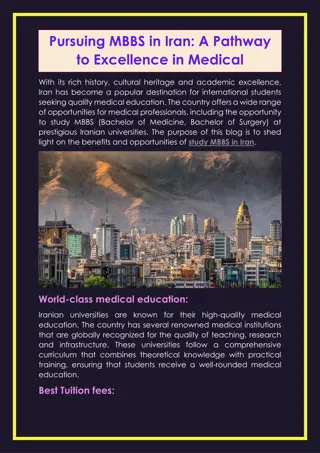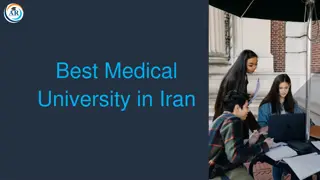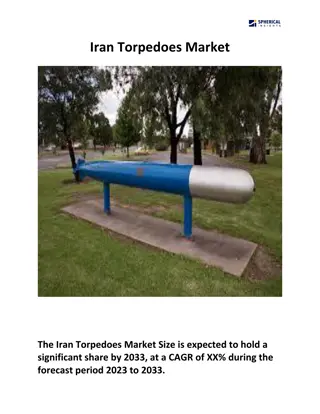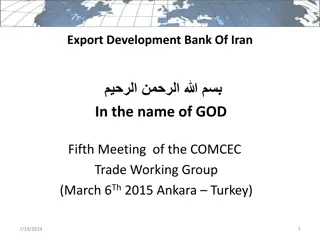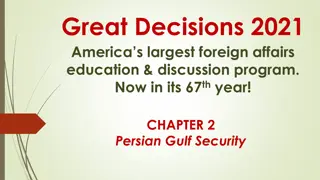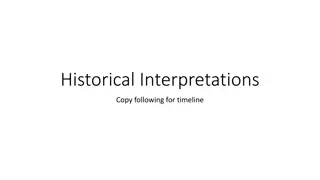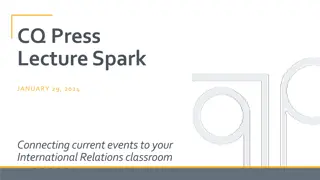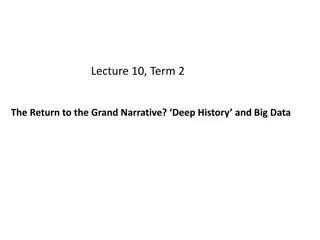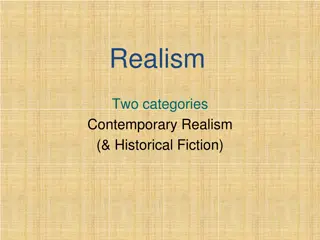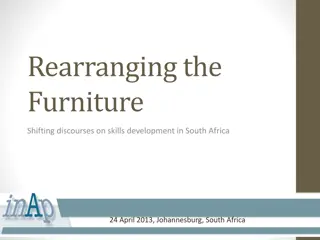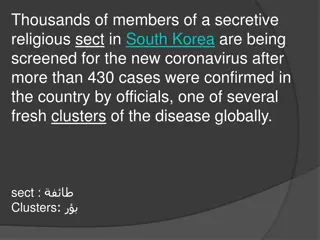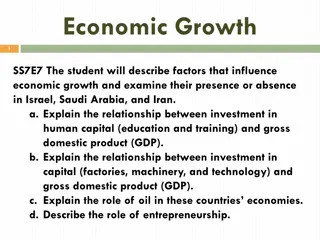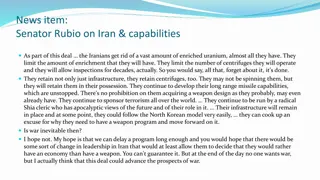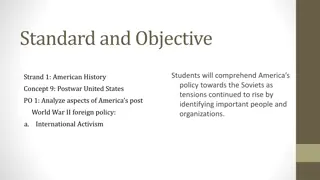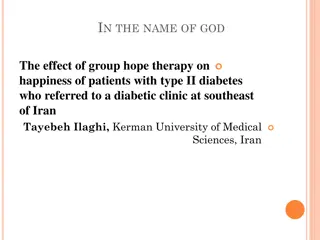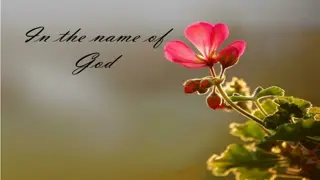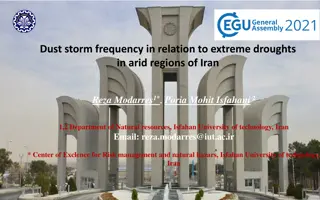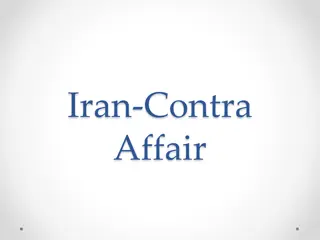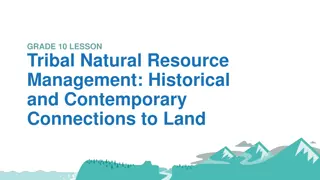Historical and Contemporary Overview of Iran
Iran, once known as Persia, has a rich history of withstanding various invasions while maintaining its national identity and pride in culture. The nation has experienced political, geographical, economic, and social transformations over the centuries, shaping its current state. From geographical details to economic conditions heavily reliant on oil exports, Iran's journey reflects its resilience and adaptability. The population's politicization and ongoing challenges underscore the complexities of Iran's past and present.
Download Presentation

Please find below an Image/Link to download the presentation.
The content on the website is provided AS IS for your information and personal use only. It may not be sold, licensed, or shared on other websites without obtaining consent from the author.If you encounter any issues during the download, it is possible that the publisher has removed the file from their server.
You are allowed to download the files provided on this website for personal or commercial use, subject to the condition that they are used lawfully. All files are the property of their respective owners.
The content on the website is provided AS IS for your information and personal use only. It may not be sold, licensed, or shared on other websites without obtaining consent from the author.
E N D
Presentation Transcript
IRAN Zach Busch, Kelsea Kitto, Payton Boyer, & Erin Fischer
FACTORS THAT HAVE HELPED SHAPE POLITICAL BEHAVIOR KELSEA KITTO http://www.iranchamber.com/history/articles/images/iranian_map_1808.jpg
Historical Background The nation of Iran, once known as Persia, has held an abundant amount of power within that region. Even with invasion of other races including Arabs, Turks, and Mongols, Iran never failed to keep its national identity. They take pride in their culture and heritage. When the invasion of the nation started, the Arabs brought Muslims, which resulted in Islam being the predominant religion. In the centuries that followed, Iran was ruled by a succession of Arab, Iranian, and Turkic dynasties. In the thirteenth century, the Mongol leader, Genghis Khan, invaded the un-united territory of Iran, and Mongol dynasties came to rule Iran for about two centuries. In 1501 the Iranian Safavis created a strong and centralized empire and also established Shia, which became their official religion (http://www.mongabay.com/reference/new_profiles/133ir.html)
Geography Area: 1.6 million sq. km. (636,295 sq. mi., slightly larger than Alaska). Arable land: 9.78% of the country. Cities: Capital--Tehran. Other cities--Isfahan, Tabriz, Mashhad, Shiraz, Yazd, Qom. Terrain: Desert and mountains. Climate: Semiarid; subtropical along the Caspian coast (http://m.state.gov/md5314. htm)
Economic Conditions Traditionally Iran was an agricultural society, but by the 1970 s Iran had achieved significant industrialization and economic modernization based on an import-substitution model, which was maintained by the demand for oil all around the world. However, the economy stopped rising after the Islamic Revolution. In March 1989, the government instituted a new 5-year plan for economic development, which loosened state control and allowed Iranians to have more access to foreign materials; however, the plan did not fully succeed. The economy of Iran ranks at the seventeenth highest in the world by purchasing power parity (PPP). The economy of Iran is a mixed, and transition economy with a large majority of the economy coming from oil and gas. Another domestic vulnerability is Iran s dependence on its oil sector; the government s chief source of revenue is from their oil exports. Iran has experienced strong economic growth in recent years due to the rise in international oil prices, but remains susceptible to oil price when the demand is low. Iran has taken steps to broaden the amount of exports that they offer, to stabilize their economy when the demand for oil isn t favorable. Iran is very much dependent on their gasoline imports to meet their consumption needs. In hopes to decrease the country s dependency on oil and gasoline in order to maintain a good economy, the county is furthering their research and would like to invest in developing their own petroleum sector (http://en.wikipedia.org/wiki/Economy_of_Iran)
Social Conditions The population is politicized, and with the current economic and social problems, the only smart solution for the preservation of cultural Islam and their social societies is to allow for political, economic, and social reforms to further gradually. Democratic reforms do not need to conflict with the culture in order to work. A prolonged confrontation between the more traditional conservative thinkers and Islamists in the regime will allow what both groups want, an Islamic Republic (http://www.state.gov/r/pa/ei/bgn/5314.htm)
Ethnic, Caste, and Religious Groups Persians are the largest ethnic group in Iran, though there are many other races that can be identified. The Arabs are the predominate ethnicity in the southwest; however there are other ethnicities that can be found in addition: Iran s population includes Kurds, Balochi, Bakhtyari, Lurs, and other smaller minorities. Percentage of Ethnic groups (2008 est.): Persian 61%, Azeri 16%, Kurd 10%, Lur 6%, Baloch 2%, Arab 2%, Turkmen and Turkic tribes 2%, other 1%. Religion: Most Iranians are Muslim; Shia branch of Islam being the dominant religion. Percentage of Religions: Shi'a 89%, Sunni 9%, Zoroastrian, Jewish, Christian, and Baha'i 2% (http://www.state.gov/r/pa/ei/bgn/5314.htm)
Ideologies It seems likely that some significant degree of shared cultural or political identity is necessary for an ambiguous ideology to serve as a point of unity at all. Thus, while ethnic divisions in Iran were certainly significant in the revolution, the main revolutionary proponents thought of themselves fundamentally as Iranians and, usually, as Shiites. The Iranian Revolution showed how rather unspecific or unrelated revolutionary ideology can be; and Ayatollah Khomeini and the "clerical radicals" demonstrated what more modern ideological directions a revolution can take as a result of the struggle to define the new regime of meaning that is an important aspect of revolutionary states (http://www.springerlink.com/content/k272155570u2ghq4/)
THE POLITICAL PROCESS PAYTON BOYER http://i-cias.com/e.o/slides/iran.politics.parliament01.jpg
How are Rulers Chosen? Of a total population of about 65 million, more than 46 million people - all those over 18 - are eligible to vote. Young people constitute a large part of the electorate with about 50% of voters being under 30. Voter turnout hit a record high at 80% in the 1997 elections which delivered a landslide victory for reformist President Mohammad Khatami. Women and young people were key to the vote. But with disillusionment growing, only about 60% of the electorate voted in the final round of the 2005 election. The president is elected for four years and can serve no more than two consecutive terms. The constitution describes him as the second-highest ranking official in the country. He is head of the executive branch of power and is responsible for ensuring the constitution is implemented.
Role of Political Parties and Interest Groups Only candidates and parties that do not oppose the religious system of governance participate in elections in the Islamic Republic of Iran. This is enforced by the clerical Guardian Council which vets candidates. Parties and candidates usually have operated in loose alignments within two main coalitions, the conservative and the reformist both of them coming from the former single-party Islamic Republic Party. Since 2009, only the conservatives have been allowed to participate and prominent reformist parties have been banned and their members jailed. There are about 74 political parties outside Iran; These 74 parties can be divided into 6 ideological branches: Communists (20 parties; the most important: the Hekmatist Party) Socialists and Social-Democrats (10 parties; the most important: Organization of Iranian People's Fedaian-Majority) Ethnic nationalists (24 parties; the main one: the Democratic Party of Iranian Kurdistan) Muslim-Democrats (5 parties; mainly the People's Mojahedin Organization of Iran and the Freedom Movement of Iran) Liberal-Democrats & Secular Nationalists (14 parties; mainly the National Front of Iran and the Constitutionalist Party of Iran) Anti-Islamic Nationalists (1 party : The Kingdom Assembly of Iran)
How do Individual Citizens Participate in Politics? All those over 18 - are eligible to vote. Young people constitute a large part of the electorate with about 50% of voters being under 30. Only candidates and parties that do not oppose the religious system of governance participate in elections in the Islamic Republic of Iran.
THE MAJOR POLTICAL INSTITUTIONS ERIN FISCHER http://i.telegraph.co.uk/multimedia/archive/02128/Ayatollah-Ali-Kham_2128806b.jpg
The Way Political Institutions Exercise Power The President Signs legislation and treaties (Central Intelligence Agency, 2009) Recognizes foreign ambassadors and selects Iranian ambassadors (Central Intelligence Agency, 2009) Presides over the Council of Ministers and selects members (Central Intelligence Agency, 2009) The Council of Ministers Serves as the equivalent of an American presidential cabinet (Central Intelligence Agency, 2009) The Guardian Council (Judiciary) Interprets the constitution (Central Intelligence Agency, 2009) The Supreme Leader Appoints important officials to the judiciary and military (Central Intelligence Agency, 2009) Controls the military (Central Intelligence Agency, 2009) Parliament Controls the financial business of the state (Central Intelligence Agency, 2009)
Inter-Relationships Between Political Institutions The president appoints the members of the Council of Ministers (Central Intelligence Agency, 2009) The Supreme Leader and the President hold similar positions, but the Supreme Leader is more influential (Central Intelligence Agency, 2009) The Supreme Leader selects important military officials, and the president takes no part in military operations (Central Intelligence Agency, 2009) The Council of Ministers works with parliament to pass legislation (Central Intelligence Agency, 2009)
Restraints on Political Institutions Council of Ministers can be removed with a vote of no confidence in parliament (Central Intelligence Agency, 2009) President has no official military power & SL does (Central Intelligence Agency, 2009) SL doesn t sign legislation, President does (Central Intelligence Agency, 2009) Judicial review is practiced by The Guardian Council on all bills (Central Intelligence Agency, 2009) Parliament can impeach the president (Central Intelligence Agency, 2009) The President can dismiss members of the Council of Ministers (Central Intelligence Agency, 2009)
PUBLIC POLICY ZACH BUSCH http://a.abcnews.com/images/Blotter/gty_saeed_jalili_iran_thg_111104_wg.jpg
Functions Performed by Political Institutions The Supreme Leader is the highest-ranking political figure in Iran. He has power over the armed forces, the ability to handpick the head of the judiciary and half the Guardian Council, makes most security and foreign policy decisions, and is even responsible for confirming the results of presidential elections (Szczepanski, 2012) The current Supreme Leader is Ayatollah Ali Khamenei (Szczepanski, 2012) The Assembly of Experts is a publicly elected body that appoints the Supreme Leader and oversees his actions. In theory, the Assembly could remove the Supreme Leader (Szczepanski, 2012) The Judiciary s purpose is to judge whether laws passed by the Majlis (parliament) conform with sharia law (Szczepanski, 2012) The Majlis is a unicameral parliament tasked with creating and voting on bills. It can also impeach the president and cabinet. The Guardian Council approves all laws passed by parliament (Szczepanski, 2012) The President is the head of government. His job is implementing the constitution, and he also has a role in making domestic and foreign policy (Szczepanski, 2012) The Expediency Council mediates conflicts between the Majlis and the Guardian Council (Szczepanski, 2012)
Establishment of Internal Order The Iranian Constitution, which provides the blueprints for the governmental structure in Iran, was ratified in 1979 and revised in 1989 (CIA World Factbook, 2012) Iran is an Islamic theocracy, and all law is based in Sharia law (CIA World Factbook, 2012) Iran is divided into 31 provinces (CIA World Factbook, 2012) While the central government of Iran is supreme, Article 7 of the Iranian Constitution calls for publicly elected City and Village Councils The Supreme Leader has the power to appoint and remove the head of television and radio, as well as the six-member council that oversees the media (Tristam 2012) The Supreme Leader is Commander in Chief of the armed forces and appoints heads of the military, law enforcement, and the Revolutionary Guard Corps (Tristam 2012) The Revolutionary Guard Corps is a branch of Iran s military that protects Iran s Islamic system (Tristam 2012)
External Security Iranian military and security are headed by the Supreme National Security Council (SNSC) and the Supreme Leader (GlobalSecurity.org, 2012) The Constitution gives the SNSC power to manage national defense and security policies, to coordinate political, intelligence, social and economic activities in relation to general defense/security policies, and to exploit material and non-material resources to address internal and external threats (GlobalSecurity.org, 2012) The SNSC also runs Iran s nuclear program Military service in Iran is compulsory for males (CIA World Factbook, 2012) It is estimated that, if necessary, Iran could mobilize up to one million men (GlobalSecurity.org, 2012) Iran s Military expenditure is approximately 2.5% of its GDP The Supreme Leader alone has the power to declare war (Tristam, 2012)
Resolving Conflict Between Different Groups Shia Islam is the majority and official religion of Iran, and religious minorities (Sunni Muslims, Zoroastrians, Jews, Christians, and Baha is) are subject to persecution (CIA World Factbook, 2012) The major ethnic minorities in Iran (Azeris, Kurds, Arabs, and Baluchis) face ethnic tensions that occasionally turn violent. Kurds have had repeated clashes with Iranian security forces (Hassan, 2008) Some minorities feel like second-class citizens, and the Kurds often have separatist tendencies (Hassan, 2008) Demonstrations by minorities can end in violence, either on the part of the protestors or by the overreaction of Iranian security forces (Hassan, 2008) Iran does not contain a single official Sunni mosque, and the government has had an active role in blocking the building of Sunni mosques (Hassan, 2008) The international community has called for additions to the Iranian Constitution defending the rights of minorities and punishing those who violate these rights. International rights groups have called for the reprimanding of Iran for its repression of women, dissidents, and religious and ethnic minorities (Hassan, 2008)
Raising Money to Pay for Services Petroleum makes up 80% of Iran s exports (CIA World Factbook, 2012) Taxes make up 27.2% of GDP (CIA World Factbook, 2012) National Budget consists of $130.6 billion in revenue and $92.22 billion in expenditures, as of 2011 (CIA World Factbook, 2012) Investment composes 27.5% of GDP (CIA World Factbook, 2012) The income tax rate is 35%, the corporate tax rate is 25%, and the sales tax rate is 1.5% (World Tax Rates, 2011)
What Services does the Government Provide? To Whom? Iran has a highly centralized 13-year (K-12) public education system. Approximately 4.7% of GDP is education expenditure (CIA World Factbook, 2012) Iran s education system is criticized internally as being too Western, and there are plans for a drastic education overhaul in the near future that will fortify Islamic values and counter the clout of the country s increasingly secularized middle class (Erdbrink, 2011) The Iranian Constitution entitles citizens to healthcare, and approximately 73% of the workforce is covered by health care and social security In 2009, health expenditures in Iran constituted 3.9% of GDP (CIA World Factbook, 2012)
Regulating the Behavior of Citizens Iranian journalists, political activists, etc. are frequently arrested for speaking out against the regime (International Campaign for Human Rights in Iran, 2011) Even peaceful demonstrations are met by brutality and arrests by the Iranian police, often followed by imprisonment, torture, denial of medical treatment in prison, and/or execution (Head, 2012) There is no separation of church and state in the Islamic Republic of Iran. Religious minorities are constantly persecuted , and those who convert from Islam to another religion may face execution (Head, 2012) Iran s Morality Police has authority to arbitrarily ban activities and items they deem to be morally questionable and/or un-Islamic, such as Barbie dolls, (Morgan, 2012) squirt guns, and women s fashion they deem too modern (Mostaghim, 2010)
Resources Central Intelligence Agency. (2009). Iran. CIA World Factbook. Retrieved from https://www.cia.gov/library/publications/the-world- factbook/geos/ir.html Erdrink, Thomas. (2011, January 1). Iran overhauls education system to erase Western influences. The Washington Post. Retrieved from http://www.washingtonpost.com/wp-dyn/content/article/2011/01/01/AR2011010101345.html Hassan, Hussein D. (2008). CRS Report for Congress: Iran: Ethnic and Religious Minorities. Retrieved from http://www.fas.org/sgp/crs/mideast/RL34021.pdf Head, Tom. (2012). Human Rights in Iran Iranian Human Rights Abuses. About.com. Retrieved from http://civilliberty.about.com/od/internationalhumanrights/p/iran101.htm GlobalSecurity.org. (2012). Supreme National Security Council. GlobalSecurity.org. Retrieved from http://www.globalsecurity.org/military/world/iran/sndc.htm International Campaign for Human Rights in Iran. (2011). Death in Prison: No One Held Accountable. International Campaign for Human Rights in Iran. Retrieved from http://www.iranhumanrights.org/2011/06/death-in-prison/ World Tax Rates. (2011). Iran Tax Rates. World Tax Rates. Retrieved from http://www.taxrates.cc/html/iran-tax-rates.html Morgan, David. (2012, January 16). Iran s morality police crack down on Barbie. CBS News. Retrieved from http://www.cbsnews.com/8301- 503543_162-57359747-503543/irans-morality-police-crack- down-on-barbie/ Mostaghim, Ramin and Alexandra Sandels. (2010, May 25). Morality Police launch crackdown on clothing and hairdos deemed un-Islamic. Los Angeles Times. Retrieved from http://latimesblogs.latimes.com/babylonbeyond/2010/05/iran-fashion-crackdown.html Szczepanski, Kallie. (2012). The Islamic Republic of Iran s Complex Government. About.com. Retrieved from http://asianhistory.about.com/od/iran/a/irangovt.htm Tristam, Pierre. (2012). Who Rules Iran? About.com. Retrieved from http://middleeast.about.com/od/iran/a/who-rules-iran.htm


